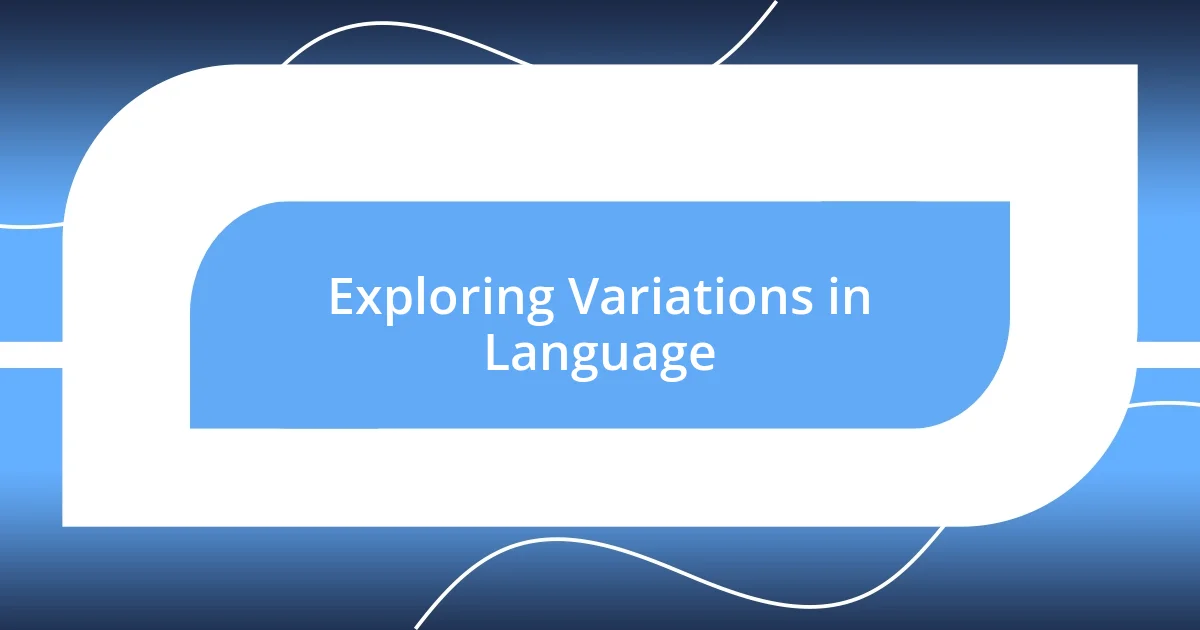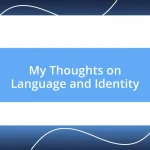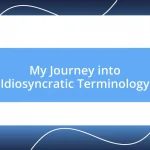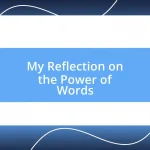Key takeaways:
- Dialects reflect cultural identity, history, and community values, shaping social connections and fostering empathy.
- Studying dialect features, such as pronunciation and vocabulary, unveils the unique linguistic and cultural elements of communities.
- Embracing dialects in education and communication enhances inclusivity, enriches learning experiences, and builds meaningful relationships.

Understanding the Importance of Dialects
When I first began exploring dialects, I was struck by how language can shape our identities. For instance, the way my grandmother spoke in her Southern drawl always filled me with a sense of belonging and nostalgia. It made me wonder: how much of ourselves do we reveal through the dialects we use?
Dialects aren’t just a collection of unique words and sounds; they carry history, culture, and community values. I remember attending a local festival where people celebrated their regional dialects, sharing stories that revealed insights about their traditions. It hit me just how much dialects influence social connections—genuine bonds often emerge from shared linguistic roots, don’t you think?
Moreover, understanding dialects enhances our empathy and awareness of diversity. Once, I overheard a conversation between two individuals from different backgrounds who initially struggled to understand each other. However, they gradually found common ground, demonstrating that embracing dialectical differences can foster mutual respect and appreciation. Aren’t we all just a bit richer for bridging those gaps?

Exploring Variations in Language
Exploring dialects opens a fascinating window into how language evolves in different environments. I recall visiting a friend’s family in New York, where I was captivated by the lively conversation that danced seamlessly between English, Spanish, and even some Italian expressions. It felt like a vibrant tapestry, illustrating how dialects can reflect the cultural mosaic of a place.
What struck me most was the sheer richness of the variations. In one conversation, I learned terms used exclusively within their community, which revealed not just language but shared experiences and values. This experience made me realize how words can act as bridges, connecting people across generations and backgrounds. Have you ever found yourself picking up phrases that carry emotional weight, changes that define not just communication, but also identity?
I also encountered dialectical humor while sharing jokes with locals. Their unique phrases gave me insight into their worldview and made me laugh in ways that transcended language barriers. These moments emphasized that language variation is not merely academic; it’s a living, breathing reflection of who we are and how we relate to each other.
| Dialect | Language Variation |
|---|---|
| Southern American English | Warm, drawn-out vowels, unique expressions like “y’all” |
| New York English | Shortened words, local slang, and code-switching |

Identifying Local Dialect Features
Identifying local dialect features can be a rewarding journey that unveils the uniqueness of a community. I remember visiting a quaint town in Louisiana, where the vibrant Creole dialect enveloped me like a warm hug. The distinctive musicality of their speech, blended with French influences, made me feel as if I were stepping into a different world. Paying attention to local expressions, intonations, and even gestures can reveal much about their cultural identity.
Here are some specific features to consider when identifying local dialects:
- Pronunciation Patterns: Notice how certain vowels and consonants are uniquely articulated. For example, the swallowed ‘g’ in ‘goin” reflects casual, relaxed speech.
- Vocabulary Choices: Listen for exclusive words or phrases, like “lagniappe” in Louisiana, meaning a little extra gift or bonus.
- Grammatical Structures: Some dialects may employ distinctive grammatical forms, such as using “ain’t” instead of “is not.”
- Code-Switching: Observe when speakers transition between languages or dialects in conversation, showcasing their cultural fluidity.
- Intonational Patterns: Different regions have unique melodic speech patterns that can be as telling as the words themselves.
In one gathering, I was delighted to hear locals discussing their day with a rhythm that was almost musical. They effortlessly switched between English and their native dialect, often leaving me in awe of their fluidity. Each turn of phrase or rhythmical change drew me in closer, sharpening my desire to understand the cultural roots that shaped their language. Isn’t it fascinating how something as simple as a conversation can tell us so much about who we are?

Analyzing Social Influences on Dialects
Analyzing the social influences on dialects reveals layers of meaning intertwined with community identity. I once participated in a linguistic exchange event, where speakers from different backgrounds shared their stories. Listening to their tales, I couldn’t help but feel how social factors like geography, migration, and local history shape the way we communicate. Isn’t it intriguing to think about how the environment we grow up in can craft our speech in such distinct ways?
One memorable moment happened when a participant from a rural area of the Midwest described their deep connection to local farming traditions. Their unique dialect reflected not just a way of speaking but a bond to their lifestyle and community values. It struck me that dialects often encapsulate shared experiences, preserving them through language. Can you recall someone whose speech immediately connected you to their culture, making you feel at home, even if you were strangers?
Moreover, I’ve observed the role of social status and education in shaping dialects. During a workshop, a scholar shared insights about how socioeconomic backgrounds influence speech patterns and vocabulary. It made me ponder the invisible lines that dialects can draw in our society, often highlighting cultural divides. Reflecting on my encounters, I realize that understanding these social layers is crucial in appreciating dialects—not just for their linguistic features, but for the diverse human stories they tell.

Techniques for Studying Dialects Effectively
Exploring effective techniques for studying dialects starts with immersive listening. I remember sitting in a local café where patrons casually exchanged stories, each word dripping with regional flair. By recording these conversations (with permission, of course), I found that I could replay nuances and catch subtleties I initially missed. Isn’t it amazing how certain phrases or the way someone stresses a syllable can transport you right into their world?
Participating in community events can also deepen your understanding. At a local festival, I volunteered to help with food stalls, which allowed me to interact closely with native speakers. Listening while completing tasks provided a natural context for learning dialect variations. Those lively exchanges made it easier for me to pick up unique idiomatic expressions. I sat there, feeling the warmth and vibrancy of the dialect surrounding me. Can you picture being wrapped in a blanket of sounds that feels both familiar and foreign at the same time?
Additionally, creating a dialect journal has been a valuable technique in my studies. I would jot down unfamiliar words and phrases, often alongside the moments that inspired my curiosity. Reflecting on these entries later, I realized I was not just capturing language but weaving a tapestry of personal memories and discoveries. This practice not only enriched my vocabulary but also allowed me to track my evolving understanding of local speech. How much more can we learn about a dialect when we connect it to our own experiences?

Practical Applications of Dialect Studies
When considering the practical applications of dialect studies, I immediately think of effective communication. For instance, during a community outreach project, I noticed how adapting my language to reflect local dialects fostered trust and rapport. It was fascinating to experience firsthand how a few well-placed regional phrases transformed my interactions, making them more meaningful and relatable. Isn’t it remarkable how mastering dialect details can bridge gaps between people?
Moreover, dialect studies can significantly enhance language teaching methods. I recall volunteering in an ESL classroom where understanding students’ dialects made lessons more engaging. By incorporating aspects of their native speech into our discussions, I helped create a space that honored their identities. This approach not only facilitated learning but also demonstrated the power of inclusivity in education. What if every language teacher embraced the dialects of their students as valuable resources rather than obstacles?
In the realm of social media and digital content, recognizing dialects can elevate storytelling. I once collaborated with a friend on a podcast series focused on local folklore, where our diverse dialects enriched the narrative. Each episode reflected the unique cultural backdrop of our regions, allowing listeners to experience a slice of our lives. Isn’t it intriguing how dialects can animate stories and bring them to life, adding depth and authenticity that resonate with audiences?

Sharing Insights from Dialect Research
One fascinating insight from my dialect research has been the way language shapes identity. I remember attending a small gathering where each participant introduced themselves using their dialect. As they spoke, I felt an overwhelming sense of pride in their voices, highlighting how dialect isn’t just a way of speaking—it’s a window into cultural heritage. Have you ever realized how a single accent can evoke memories, feelings, and a sense of belonging?
Moreover, I learned that dialects evolve over time, influenced by many factors including migration and technology. While researching, I stumbled upon a recording from decades ago featuring my hometown’s speakers. Listening to their distinct expressions and pronunciation, I couldn’t help but smile at the vivid contrasts with the current dialect. It made me wonder: how much of our language transforms within just a few generations?
A particularly eye-opening moment came when I attended a workshop on dialect diversity in education. I saw how embracing various dialects in classroom settings could empower students to express their unique voices. As I watched those kids engage confidently, I realized that validating their dialects was not just about language but about affirming their very existence. Isn’t it empowering to recognize that our differences enrich the tapestry of communication?












